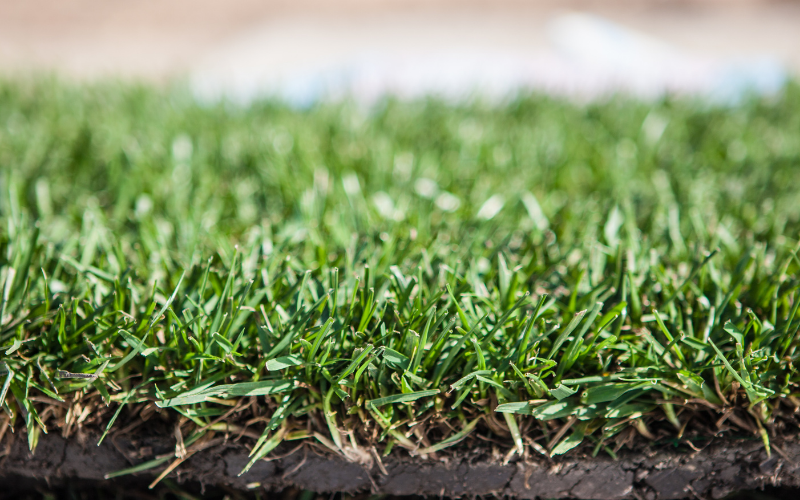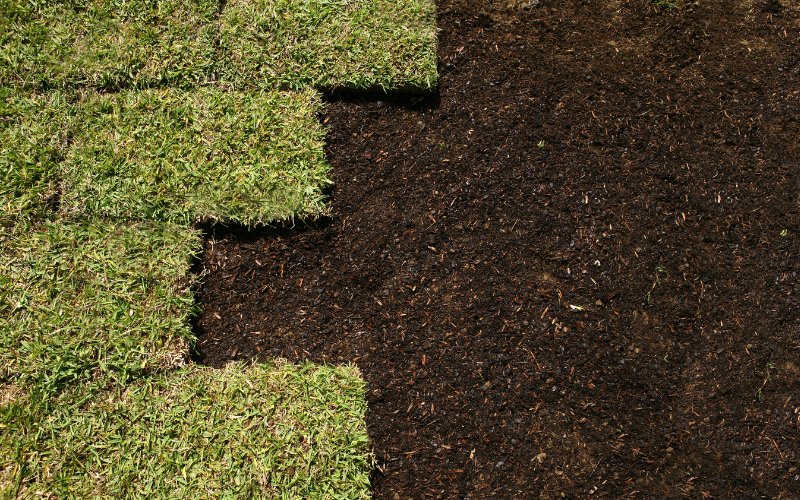Sod that appears healthy but that lifts easily after several weeks is easily one of the most frustrating situations you could have when trying to create a new lawn. However, there are usually a few common reasons why this is happening. Below you can learn what these reasons are as well as how to fix them using tried-and-true methods.
Sod Not Taking Root? – The Short Explanation
There are two primary reasons why sod won’t take root. The first is because the sod is perfectly happy as it is. It’s damp, well-fed, and has no reason to spend energy sending roots out into the soil. The second is because it has no energy to send out roots into the soil.
Getting sod to root requires a delicate balance of providing what the sod needs but providing it in such a way that the sod doesn’t get comfortable. The sod needs to feel like it has to take root to survive but you need to do that without actually harming it and forfeiting your investment. It may sound a little complex but there is a formula for getting it to work. First, however, you want to make certain that your sod hasn’t begun to take root.
How to Tell If Sod Has Taken Root
There is one simple method to tell if your sod has taken root or not. All you need to do is find the end of one piece of sod. Take ahold of the grass growing from the sod near the seam. Hold firmly and tug straight up. Gently at first but with a little more force each time until you are sure that there is firm resistance.
If you feel firm resistance, your sod has taken root. If you can lift up or peel back the sod without feeling resistance, your sod has not fully taken root. However, that does not mean the process hasn’t started. Look at the bottom of the piece of sod- are there any roots dangling down from the main root mat? If so, your sod is in good shape. If no visible roots are forming down toward the ground, you may have a problem.
Why is My Sod Not Rooting?
There are 6 reasons why sod might not take root. The good news is that no matter which of these issues you have, the way to fix it and get things back on track is almost the same. Still, it’s good to know which of these factors led to your sod not taking root in the first place so you can avoid falling into that trap again in the future.
Time
Depending on the type of sod you have, the time of year, and your climate it may take as little as one week for your sod to root but it could take as long as 5 weeks. Zoysia grass, for example, can take 2 full months to be rooted enough, from sod or plugs, to provide sufficient resistance to prove that it is rooted. Having the patience to wait for the sod to root, especially if things haven’t seemed to change for more than a month, is something I struggle with too.
Floating Sod
Floating sod can be nearly impossible to avoid unless you or your lawn installer used heavy equipment to press the sod into place. However, this equipment can lead to soil compaction, the next most likely reason your sod hasn’t taken root.
Floating sod is something you get when there’s an air pocket under your sod. This makes the sod feel like there isn’t anything down there to extend its roots into, so it won’t go to the effort.
Soil Compaction
Soil compaction is a lot like having a floating sod problem. In this case, however, instead of the sod feeling like there’s nothing to root into, it feels like there is too much there to root into. Compaction leads to the ground being so hard that the roots of the grass are unable to dig into it. This happens less often with grass types that produce stolons or rhizomes such as Bermuda grass and St. Augustine.
Compaction is fairly common if you are using sod to create a lawn comprised of cool-season grasses that are typically started from seed. This includes perennial ryegrass and tall fescue.
Mowing Too Often or Too Short
Sod is a strip of grass that has already been cut away from where it’s used to being, either physically or metaphorically. It has a new climate, a new type of light, and new nutrient, water, and pH situations to deal with. That’s a lot of change and the plant is stressed. Mowing the sod now adds even more stress, sometimes to a level that will become intolerable and the sod’s period of dormancy may increase.
Over- or Under-Watering
Water is the big thing to pay attention to with sod that isn’t rooting. Water, too much or too little, is the biggest deciding factor when it comes to sod developing a new root system or not. Too much water too often and the sod may decide that reaching down into the ground isn’t worth the effort. Too little water, on the whole, may mean that the sod needs to decide between making enough food to maintain its current health and shape for another day or growing more roots. Roots are not the popular choice in this case.
Application of Fertilizer (Too Much or Too Early)
Sod that does not have a well-developed or integrated root system will be easily burnt by the application of strong fertilizers. This is why compost or other natural slow-release fertilizers are frequently added before the sod is placed.
What To Do If Sod is Not Taking Root
Getting your sod to take root, if you have already inspected it and things are not progressing as they should, is all about the process. No matter where you are or what type of grass you’re working with, getting sod to root takes the same steps. This is how to get sod to take root:
Aerate the Soil
Before moving on, it’s important to ensure that your soil is loose. Compacted soil will make it so that none of the following steps will make a difference. This is, however, groundwork. You’ll need to take up your sod to get things to where they need to be. If your soil is already loose, feel free to skip ahead.
To aerate your soil, you can use a chemical product that is safe to use before seeding or laying sod. You could also manually use a heavy rake or machine to aerate the ground at least 2 inches deep across the surface where the sod will be placed.
Apply Fine Compost
Before laying down the sod, apply a thin layer of fine compost to the surface of the yard. Rake or roll over this addition to ensure that it is even but not compacted. This will provide a burst of slow-release nutrients over time and can encourage faster rooting as the rich compost will provide the promise of nutrients to the stressed sod.
If your soil is already rich or on the loamy side, this step may be skipped. However, if you already have your sod up or you’re still in the research phase, this step could be worth the effort.
Use a Lawn Roller
A nice, heavy lawn roller should be used on the sod once it is placed where it needs to be. This helps ensure that there are no air pockets and that each piece of sod has full and even contact with the ground underneath.
Soak the Sod
The schedule for watering sod is something that needs a lot of care and attention. The basic schedule I recommend is as follows:
- 15 to 20 minutes of watering with traditional sprinklers 2x per day for 10 days
- Watering for 15 to 20 minutes once a day every other day for 7 days
- Watering 2x/week for 30 minutes each session for 1 week
- And finally watering deeply for 45 minutes to an hour just once a week thereafter
These are the four stages that you should go through from the first week your sod is placed to the 4th or 5th week when you only need to water your new lawn deeply. That final step is key. Watering your lawn deeply will encourage root growth while shallow, frequent watering like in the first week can help the sod heal and reduce stress. Ideally, for best results, you should only water your lawn from 12 am to 5 am, too.
Don’t Use Heavy Fertilizers on Your Lawn Too Early
After 4 weeks, you are free to add a light, slow-release nitrogen fertilizer or some compost or compost tea to the lawn. If you have already applied too heavy a dose of fertilizer, soak your lawn 3x per week for one week instead of the usual watering schedule. This can help flush some of the extra fertilizer further into the soil without interrupting the sod too much.
Let The Sod Grow Uninterrupted
Last, allowing your sod to grow even beyond its ideal lawn height for these first 4 to 8 weeks can help prevent stress and encourage rooting over the development of stems and leaves. When possible, avoid mowing any new sod until it has strong new roots.




Raccoons are rolling up my new (10 day old) sod. I live in the Seattle area and it’s been cool and wet – any suggestions?
Hi Don,
That’s annoying! If the weather is wet and cool after sod is installed, grubs and worms are likely being forced to the surface. The raccoons will sense an opportunity and roll up your sod. In cases like this, installing protective mesh or netting over the sod is usually the best line of defense. Chicken wire, though more expensive, is a fool-proof solution.
Beyond this, motion detectors with flashing lights or spinning parts can be used to deter raccoons. Less effective methods, if the mesh and flashing lights don’t work, include scattering mothballs around your lawn or using a strong mixture of cayenne pepper to deter animals without harming your sod.
I hope this helps 🙂 Let me know how you get on!
Help! We had zoysia sod installed late last summer. We followed all the needed watering instructions, etc but this spring, it is still brown, not showing signs of greening and many areas appear to not have rooted. Besides pulling up all the sod (installed were squares, not rolled), what other options do we have to save this lawn? We live in upstate South Carolina – home to red clay dirt! Thank you!
Hi Barbara,
I’m going to assume that the sod was fine during the last summer and fall, so you’ve only noticed an issue after the winter. Therefore, the issue could be the red clay and dirt. Clay is notorious for causing issues with drainage, air exchange, and nutrient availability. The best approach to overcome these types of problems is to aerate your lawn.
Here’s an article I wrote that outlines how to aerate your lawn:
https://lawnmowerguru.com/how-to-aerate-a-lawn/
Also, you might want to consider adding some better-quality soil to the top of your lawn. This can be done by using a method called “lawn topdressing”. You basically add soil on top of your lawn in small amounts to improve the soil quality.
It’s common for sod to die if the soil conditions are not right. So, even if you replace the lawn, the underlying problem will still remain. Hopefully, fixing the soil will give your lawn a better chance of maturing.
Thanks for the question.
Tom.